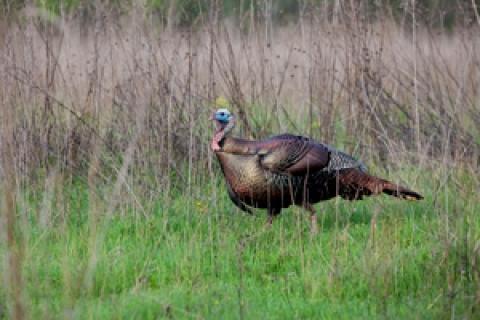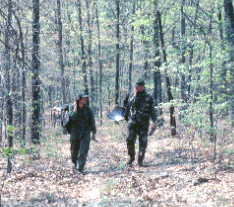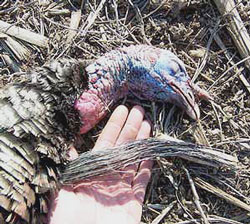

I was a young hunter, and he was an old gobbler, and the lesson he taught me has stuck to this very day.
I had what I felt was a good setup on the side of an open hardwood ridge. I'd heard the turkey gobbling from long range and moved in, careful not to spook him. When I'd slipped as close as I dared, some 125 yards, I picked a tree, hunkered down and proceeded to dole out the sweetest, most enticing hen notes I could muster.
The gobbler responded immediately. The force of his answer seemed to shake the leaves on the saplings around me. In a few minutes he gobbled again, closer, and I smugly got ready for the kill.
Ten minutes later I spotted the old bird, alternately strutting, then relaxing his mating posture and peering in my direction. He moved a few steps closer with each of these sequences. My adrenalin and confidence levels raced each other to see which could climb the highest.
Then the gobbler hit an invisible barrier, and he locked up. He was in plain view some 70 yards out, and he stayed there more than an hour. He strutted, gobbled, watched, even scratched in the leaves and pecked at insects. But he never came another step closer.
I was in a real fix. I couldn't move, or he'd see me and bolt. I tried a couple of quiet calls, which prompted the tom back into his strut. However, in a minute or two he'd relax again and continue staring in my direction.
Finally this longbeard had enough of my unfulfilled promises. He turned and nonchalantly walked away. After he disappeared, I took a rounder and called from another location. He gobbled a couple more times, but he never made another move my way. He'd done his part to rendezvous with the hen. Now he knew something was fishy, and he wasn't about to get hooked!
What lesson did this turkey teach me? Not to set up in an area that's too open. I'd have been far better off picking a calling spot where the trees were a little thicker or just over the crest of the ridge, somewhere the bird would have been in range when he showed himself. Instead, when he got close enough to see the hen through the open woods, and none was there, his suspicion overcame his urge to mate, and this old boy lived to gobble another day.
Turkey hunters learn from the birds they pursue, or they should. No doubt, neophytes can profit from reading magazines and books and watching videos. They can soak up knowledge from seasoned hunters in seminars or fireside bull sessions. However, the real education in this sport comes one-on-one in the field. There is no better instructor than a four or five year longbeard with survival instincts as sharp as a honey locust thorn. Such a bird is like a drill sergeant who teaches lessons the hard way. Pay a price, make your mistakes and gain the experience. This is the real way to learn to hunt turkeys.
Following are narrations of three other veteran hunters about gobblers which have taught them valuable lessons over the years. These stories underscore that each hunt is a learning experience, and each longbeard, especially an old one, can enlighten hunters who turn their receivers on.
Jim Strader: Use a Gobbler's Strengths Against Him
Jim Strader of Louisville, Kentucky is a writer, radio show host and producer of an annual outdoor expo in Derby City. However, when spring arrives, Strader puts these endeavors on hold and hits the turkey woods for several weeks running. He's compiled many seasons of experience and learned volumes of longbeard lessons, one of which sticks most prominently in his memory.
Strader begins, "Several years ago I located a gobbler in Butler County, Kentucky that turned out to be the toughest bird I've ever hunted. He roosted on a long ridge that curved like a horseshoe around a fescue bottom. Every morning he'd fly down, gobble a few times, and make a beeline for the pasture. Then he'd spend the morning strutting out in the open field where it was impossible to get him.
"I tried all the standard strategies: Intercepting him on the way to the bottom, calling him from the edge of the pasture, ambushing him as he left the field. Nothing worked. There was no pattern in his movements," Strader continues. "The only thing predictable was that he would go to that field where he could see a long way around him. So finally I came up with a plan to make this strength and confidence work against him."
Strader continues, "One morning after I finished hunting, I got three bales of hay and drove out in the pasture where the gobbler strutted. I cut the strings and piled the hay in a low mound. Then I left this area alone for 3 days.
"On the fourth morning, I slipped into the field before dawn and set up a turkey decoy 20 yards from the hay pile. Then I spread a poncho next to the hay, lay down on it, pulled a thin layer of hay back over me, and waited for the gobbler to show up.
"He followed his routine to the letter. He gobbled off the roost, flew down and gobbled a half dozen more times from the ground. Then he got quiet, and I got ready.
"Ten minutes later he showed up on the edge of the field. He saw my decoy, bowed up and started strutting toward it. By now he was used to the pile of hay in his strutting zone, and he paid it no attention.
"I let him come almost to the decoy, then I raised up quickly with my shotgun. He hesitated just long enough for me to get a shot off. He was one of the biggest gobblers I've ever killed, and also one of the most satisfying."
So what lesson did Strader gain from this experience? "I learned to figure out what a gobbler's main defense is and to use it against him. Decide what strength or pattern he's relying on most, and turn the table on him. This particular turkey was depending on his eyes to keep him out of trouble, and I figured out how to use his vision against him. The hay allowed me to disappear in the open pasture, and the decoy held his attention and drew him to a spot where I could shoot him." Strader concludes, "When you start thinking that a turkey is unkillable, it's time to back away from normal hunting techniques. Sometimes, trying something unconventional will yield surprising results. Too many hunters limit themselves by not being creative in designing their strategies."
Lamar Williams: Patience to Work in Your Favor
 |
| "If I don't spook the bird and I stay right in there, chances are he'll eventually come looking for me, and then hopefully I'll get him." |
Lamar Williams of Starke, Florida makes and markets some of the finest turkey box calls in the country. This longtime woods warrior uses these calls personally many mornings each season on longbeards between Jacksonville and Gainesville. Frequently he hunts on wildlife management areas, and last spring he had an experience which drove home an important point about pursuing gobblers, especially those which are pressured.
Williams narrates, "My son and I were hunting on the Camp Blanding WMA, and one morning before dawn we went into an area where we'd heard a couple of turkeys gobbling the day before. When dawn broke, one bird cranked up pretty good, so we left the graded road and walked 150 yards down a fire break toward the turkey, which was about another 100 yards out in the woods. We set up just off the fire break, thinking he might make his approach along this opening.
"Now, this is palmetto country, and it's very thick and hard to maneuver through. Also, it's noisy when the underbrush is dry, so we do a lot less moving here than some hunters do in other parts of the country where the terrain is more open." Williams continues, "This turkey gobbled pretty good on the limb, and my son and I alternated calling to him very lightly and infrequently. There's a lot of hunting pressure on most of the WMAs in Florida, and it's easy to overcall a gobbler and scare him.
"I don't know if this turkey was spooky or conceited or what, but he stayed in the tree and gobbled for at least an hour after daylight. We didn't know what to do. When we'd call, he'd double and triple-gobble, but he wouldn't fly down.
"Finally we quit calling for 15 minutes. Then I cut at him, and he gobbled off to my right. He was on the ground and moving down the edge of a thick swamp. Most hunters would have gotten up and tried to maneuver on him, but we didn't feel we had any chance doing this successfully because of the thick undergrowth.
"Finally that turkey walked all the way to the graded road where our truck was parked. Then he turned down the road to the fire break where we'd walked in, and he came down that trail behind us, strutting and gobbling every few minutes. He took his own sweet time, but he finally got to us, and we laid him low. He was a nice gobbler that I'll always remember." The lesson for other hunters? "Don't get impatient and give up on a place or a turkey too soon, especially where the birds hear a lot of calling," Williams emphasizes.
"You have to hunt a gobbler by his clock, not by your's. Sometimes it can take him quite awhile to decide to come in, for whatever reason.
"Many modern hunters move and call a lot. If they get on a turkey that doesn't come pretty soon, they go looking for another one. Now this strategy works a lot of times, but I also feel it costs hunters some turkeys they would have gotten if they'd been more patient. The longer I hunt, the more prone I am to staying put an hour or two even if a turkey shuts up on me. If I don't spook the bird and I stay right in there, chances are he'll eventually come looking for me, and then hopefully I'll get him."
Will Primos: Natural Sounds Lure in Longbeards
Will Primos of Jackson, Mississippi, is a call maker, video producer and seminar giver of broad celebrity in the outdoor world. Primos has pursued turkeys throughout North America, developing his products and imaginative tactics. His reputation for being on the cutting edge of this sport is well deserved. He is an avid student of nature, and he frequently applies his discoveries in his hunting strategies.
For instance, Primos places strong emphasis on imitating turkey sounds other than vocalizations. This stemmed from a hunt he experienced along Mississippi's Big Black River in the late 1970s.
Primos relates, "I got a fixation on an old gobbler that roosted in a strip of woods bordered by the river on one side and a big open soybean field on the other side. I hunted him several days in a row, but I never had any luck with him. He'd answer when I called, but he wouldn't come. Instead, when he left his roost tree, he'd fly out into the field and strut for hours on end. I kept a diary back then, and I go back every once in awhile and read how that turkey was playing with my mind. "One particular morning, everything was proceeding as usual. He'd gobbled off the roost, and I'd slipped into the woods and set up fairly close to him. But before I started calling, I heard something walking behind me. The woods were real dry, and whatever it was was going 'clomp, clomp, clomp' in the leaves.
"I peeped around and watched a big hen go by, heading for the gobbler. He could hear her coming, and he started gobbling a steady stream. Then the first thing I knew, he sailed out of the tree and hit the ground right next to her, just beyond gun range. I watched dumbfounded as those two turkeys disappeared in the woods.
"I waited a couple of days before coming back here again. Then, when the gobbler cranked up, instead of setting up and calling, I just started walking in the leaves toward him: 'Clomp, clomp, clomp,' just like the hen had done. I had my gun up and ready. Sure enough, that turkey gobbled several times at me, then he pitched out of the tree and flew right to me. I shot him just as his feet touched the ground."
Primos continues, "Since then, I've studied how turkeys use and respond to sounds other than vocalizations. Walking in dry leaves has worked for me several other times since that first experience on the Big Black River. Another well-known example is scratching in leaves to simulate feeding.
"Also, I flap a turkey wing to imitate a hen flying down or changing limbs. And sometimes I'll rake a wing across a limb or against a tree trunk so the feathers will make a light brushing sound. This is real subtle, but it's loud enough for turkeys to hear it. I started doing this after watching a gobbler go crazy one morning to the sound of other turkeys walking down a limb."
Primos concludes, "Here's the point. There are several natural sounds you can use to convince a gobbler that you're a hen instead of another hunter with a turkey mouth call. These little tricks may be just the medicine for older birds that'll ignore conventional hunting methods."
Encounters Teach More About Turkey Hunting
Thus, each new encounter with a gobbler is another chance to learn more about these birds and how they react to different factors in their environment. Turkey buffs should consciously view hunts in this light and analyze every one for snippets of knowledge which may be applied in other, similar situations in the future.
Jim Strader says, "I've chased these birds for 20 years, and just about the time I think I've got'em figured out, a gobbler does something completely off the wall, and I just shake my head and think, 'What are they going to do next?'
"And you know what? That's what makes turkey hunting such a great sport. The birds are the teachers, and there's always something new to pick up from them, another lesson to master, another trick to try. Man, I love it!"
- 7107 views

